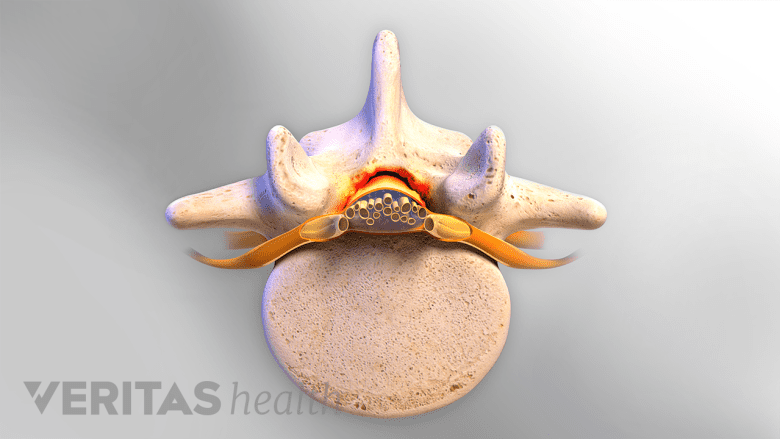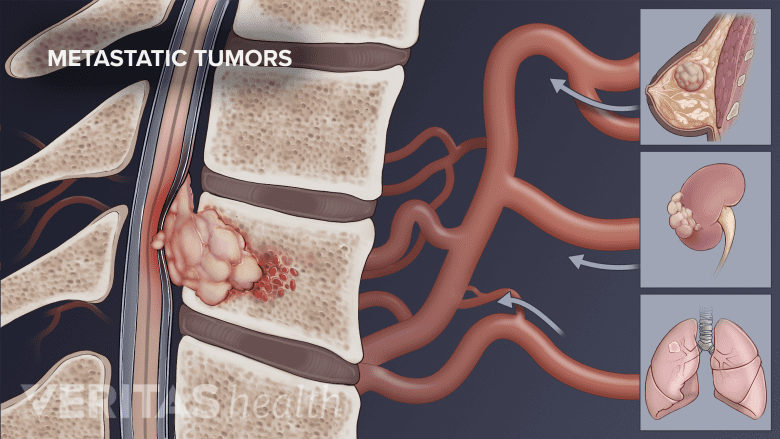Cauda equina syndrome occurs when any mechanical or inflammatory issue causes cauda equina compression to the point of neurological disruption or damage.
In This Article:
- Cauda Equina Syndrome
- Cauda Equina Syndrome Symptoms
- Causes of Cauda Equina Syndrome
- Treatments for Cauda Equina Syndrome
- Cauda Equina Syndrome Video
Lumbar Herniated Disc: The Most Common Cause of Cauda Equina Syndrome
Nerve compression leading to cauda equina syndrome is most often caused a lumbar herniated disc. A lumbar disc can herniate in a single injury when excessive pressure is placed on the lower spine, or can occur when an already weakened disc is strained and ruptures.
Typically, a herniated disc will not affect the cauda equina. Only between 2% and 6% of lumbar disc surgeries are performed to treat cauda equina syndrome.1Gardner A, Gardner E, Morley T. Cauda equina syndrome: a review of the current clinical and medico-legal position. Eur Spine J. 2011;20(5):690-7
Less Common Causes of Cauda Equina Syndrome
In addition to lumbar herniated disc, it is possible for the following factors to impinge on the cauda equina and cause symptoms.
Lumbar spinal stenosis
Lumbar spinal stenosis may cause cauda equina syndrome by compressing the spinal cord.
If the lumbar stenosis puts pressure on the spinal canal, cauda equina may result.
Inflammatory conditions
Inflammatory conditions can contribute to cauda equina syndrome if bony overgrowth or inflamed tissues press on lumbar nerve roots. One example of an inflammatory condition that may possibly lead to cauda equina syndrome is ankylosing spondylitis.
Watch Ankylosing Spondylitis Video
Infections of the spinal canal (osteomyelitis)
Certain infections of the spinal canals such as a spinal epidural abscess, which in turn may potentially press into the spinal canal, producing neurological symptoms.
See Osteomyelitis, a Spinal Infection
Tumors/neoplasms
Spinal tumors may cause impingement of nerves, resulting in severe neurological symptoms.
Spinal tumors near the spine may put pressure on the spinal canal. Tumors may originate in the spine, but it is more common that cancer from another part of the body spreads toward the spine (malignancy).
See Symptoms of a Spinal Tumor
Trauma to the lumbar spine
Incidents such as a car accident, fall, or a penetrative injury such as gunshot or knife wound, can damage the cauda equina and produce neurological symptoms.
Postoperative complications from lumbar surgery
A small number of patients experience cauda equina syndrome following surgery to repair a lumbar herniated disc.
Risk factors for the condition are similar to risk factors for spinal stenosis and lumbar herniated disc, including overall health and lifestyle (such as nicotine use, obesity, and low activity level), being between 30 and 50 years old, and labor-intensive work.
Diagnosing Cauda Equina Syndrome
An MRI scan is a useful diagnostic tool to diagnose cauda equina syndrome.
Magnetic Resonance Imaging (MRI) is the standard method of confirming the presence of cauda equina syndrome and for planning surgical treatment. The sooner cauda equina syndrome can be diagnosed, the better chance the patient has to make a sound recovery and experience as few lingering symptoms of nerve damage as possible.
- 1 Gardner A, Gardner E, Morley T. Cauda equina syndrome: a review of the current clinical and medico-legal position. Eur Spine J. 2011;20(5):690-7








